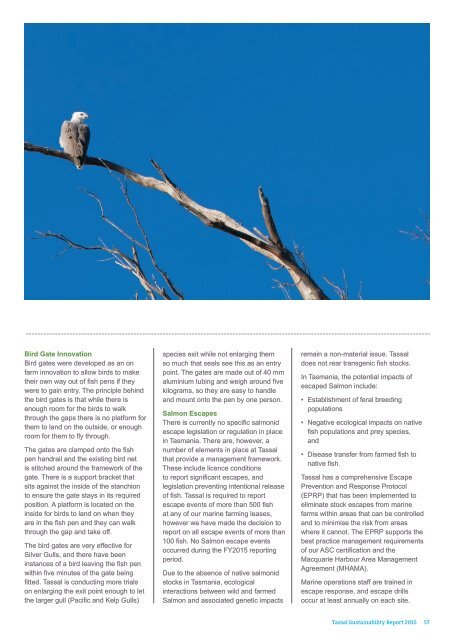SUSTAINABILITY REPORT 2015
kbiQcx
kbiQcx
You also want an ePaper? Increase the reach of your titles
YUMPU automatically turns print PDFs into web optimized ePapers that Google loves.
Bird Gate Innovation<br />
Bird gates were developed as an on<br />
farm innovation to allow birds to make<br />
their own way out of fish pens if they<br />
were to gain entry. The principle behind<br />
the bird gates is that while there is<br />
enough room for the birds to walk<br />
through the gaps there is no platform for<br />
them to land on the outside, or enough<br />
room for them to fly through.<br />
The gates are clamped onto the fish<br />
pen handrail and the existing bird net<br />
is stitched around the framework of the<br />
gate. There is a support bracket that<br />
sits against the inside of the stanchion<br />
to ensure the gate stays in its required<br />
position. A platform is located on the<br />
inside for birds to land on when they<br />
are in the fish pen and they can walk<br />
through the gap and take off.<br />
The bird gates are very effective for<br />
Silver Gulls, and there have been<br />
instances of a bird leaving the fish pen<br />
within five minutes of the gate being<br />
fitted. Tassal is conducting more trials<br />
on enlarging the exit point enough to let<br />
the larger gull (Pacific and Kelp Gulls)<br />
species exit while not enlarging them<br />
so much that seals see this as an entry<br />
point. The gates are made out of 40 mm<br />
aluminium tubing and weigh around five<br />
kilograms, so they are easy to handle<br />
and mount onto the pen by one person.<br />
Salmon Escapes<br />
There is currently no specific salmonid<br />
escape legislation or regulation in place<br />
in Tasmania. There are, however, a<br />
number of elements in place at Tassal<br />
that provide a management framework.<br />
These include licence conditions<br />
to report significant escapes, and<br />
legislation preventing intentional release<br />
of fish. Tassal is required to report<br />
escape events of more than 500 fish<br />
at any of our marine farming leases,<br />
however we have made the decision to<br />
report on all escape events of more than<br />
100 fish. No Salmon escape events<br />
occurred during the FY<strong>2015</strong> reporting<br />
period.<br />
Due to the absence of native salmonid<br />
stocks in Tasmania, ecological<br />
interactions between wild and farmed<br />
Salmon and associated genetic impacts<br />
remain a non-material issue. Tassal<br />
does not rear transgenic fish stocks.<br />
In Tasmania, the potential impacts of<br />
escaped Salmon include:<br />
• Establishment of feral breeding<br />
populations<br />
• Negative ecological impacts on native<br />
fish populations and prey species,<br />
and<br />
• Disease transfer from farmed fish to<br />
native fish.<br />
Tassal has a comprehensive Escape<br />
Prevention and Response Protocol<br />
(EPRP) that has been implemented to<br />
eliminate stock escapes from marine<br />
farms within areas that can be controlled<br />
and to minimise the risk from areas<br />
where it cannot. The EPRP supports the<br />
best practice management requirements<br />
of our ASC certification and the<br />
Macquarie Harbour Area Management<br />
Agreement (MHAMA).<br />
Marine operations staff are trained in<br />
escape response, and escape drills<br />
occur at least annually on each site.<br />
Tassal Sustainability Report <strong>2015</strong> 57


